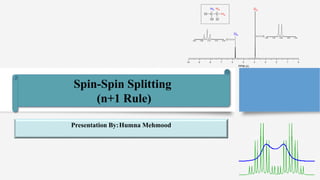
Spin spin splitting (n+1 Rule) NMR spectroscopy
- 1. Presentation By:Humna Mehmood Spin-Spin Splitting (n+1 Rule)
- 2. Spin-Spin Splitting The absorption signal due to a particular proton may split into double(two peaks), triplet (three peaks) and so on. This phenomenon is commonly known as spin-spin splitting. Spin-spin splitting occurs only between nonequivalent protons on the same carbon or adjacent carbons. Spin–spin splitting can be explained empirically by the so-called n + 1 Rule. “Each type of proton senses the number of equivalent protons (n) on the carbon atom(s) next to the one to which it is bonded, and its resonance peak is split into (n + 1) components”.
- 3. Multiplicity • The no. of peaks into which the absorption signal split is called multiplicity.
- 4. The Origin Of Spin–spin Splitting • Spin–spin splitting arises because hydrogens on adjacent carbon atoms can “sense” one another. The hydrogen on carbon A can sense the spin direction of the hydrogen on carbon B. • The chemical shift of proton A is influenced by the direction of the spin in proton B. Proton A is said to be coupled to proton B(spin-spin coupling). • The resonance of proton A is said to have been split by proton B, and the general phenomenon is called spin–spin splitting.
- 5. GENERAL RULES FOR SPIN-SPIN SPLITTING Three general rules describe the splitting patterns commonly seen in the 1H NMR spectra of organic compounds. 1.Equivalent protons do not split each other’s signals. 2.A set of n nonequivalent protons splits the signal of a nearby proton into n + 1 peaks. 3.Splitting is observed for nonequivalent protons on the same carbon or adjacent carbons.
- 6. Proton spectrum of ethanol
- 7. Examine the case at hand, 1,1,2-trichloroethane, utilizing the n + 1 Rule.
- 8. 1,1,2-trichloroethane, utilizing the n + 1 Rule • First the lone methine hydrogen is situated next to a carbon bearing two methylene protons. According to the rule, it has two equivalent neighbors (n = 2) and is split into n + 1 = 3 peaks (a triplet). • The methylene protons are situated next to a carbon bearing only one methine hydrogen. According to the rule, these protons have one neighbor (n = 1) and are split into n + 1 = 2 peaks (a doublet).
- 9. Consider the spectrum below:
- 10. How do the doublet due to the CH2 group on BrCH2CHBr2 occurs? When placed in an applied electric field, (B0), the adjacent proton (CHBr2) can be aligned with () or against () B0. Thus, the absorbing CH2 protons feel two slightly different magnetic fields—one slightly larger than B0, and one slightly smaller than B0. Since the absorbing protons feel two different magnetic fields, they absorb at two different frequencies in the NMR spectrum, thus splitting a single absorption into a doublet.
- 11. How A Doublet Arises?
- 12. How do a triplet arises? • When placed in an applied magnetic field (B0), the adjacent protons Ha and Hb can each be aligned with () or against () B0. • Thus, the absorbing proton feels three slightly different magnetic fields—one slightly larger than B0, one slightly smaller than B0, and one the same strength as B0.
- 13. How do a triplet arises? Because the absorbing proton feels three different magnetic fields, it absorbs at three different frequencies in the NMR spectrum, thus splitting a single absorption into a triplet. Because there are two different ways to align one proton with B0, and one proton against B0—that is, ab and ab—the middle peak of the triplet is twice as intense as the two outer peaks, making the ratio of the areas under the three peaks 1:2:1. Two adjacent protons split an NMR signal into a triplet. When two protons split each other, they are said to be coupled. The spacing between peaks in a split NMR signal, measured by the J value, is equal for coupled protons.
- 14. How do a triplet arises?
- 15. Splitting is not generally observed between protons separated by more than three bonds.
- 17. The H NMR spectrum of 2-bromopropane, (CH3)2CHBr
- 18. Spectrum of ethyl iodide
- 19. Spectrum of ethyl iodide • Notice that the methylene protons are split into a quartet (four peaks), and the methyl group is split into a triplet (three peaks). This is explained as follows:
- 21. Spectrum of 2-nitropropane • In the case of 2-nitropropane there are two adjacent carbons that bear hydrogens (two carbons, each with three hydrogens), and that all six hydrogens as a group split the methine hydrogen into a septet.
- 22. Pascal’s Triangle • We can easily verify that the intensity ratios of multiplets derived from the n + 1 Rule follow the entries in the mathematical mnemonic device called Pascal’s triangle. • Each entry in the triangle is the sum of the two entries above it and to its immediate left and right. • Notice that the intensities of the outer peaks of a multiplet such as a septet are so small compared to the inner peaks that they are often obscured in the baseline of the spectrum.